
![]() The Sub-Weapons, cont.
The Sub-Weapons, cont. ![]()
The Belmonts, to a person, have always wielded great power. Over the centuries, each generation has grown more powerful than the last. Along with that necessary increase in potency comes the ability to give sub-weapons and special weapons an added boost. If the hero finds himself with a large amount of hearts while in a dire scenario, he or she can activate a superpowered barrage of a given sub-weapon. While Richter was the first known Belmont to use this technique, even Leon Belmont was known to enhance the propensity of his sub-weapons--though, he needed special orbs as a conduit--before item-crashes became an innate ability. Truly, it was Juste Belmont who played a big hand in shaping the evolutionary power and giving it standard form (see Harmony's weapons page for information on "Spell Fusion"). We'll on this page take a gander at item-crash powers and those derivative of them.
Basic Weapons | Special Additions | Sypha's Spells | Maria's Weapons | Sonia's Soul Powers | Haunted Castle Exclusive | Item-Crashes
|
Item-Crashes
|
Dagger

|
As mentioned: The dagger has always been a rather useless weapon due to its weak striking power. Richter expanded on the dagger's usefulness by chucking three at a time, creating a larger field of attack and more hit-potential. As an item-crash, Richter will go berserk, tossing daggers at high speed, one after another, both high and low for an extended period of time. Grounded foes will be engulfed by the storm, but those airborne might stand a better chance of evasion. Richter can use this item-crash in Rondo and his unlockable quest in Symphony, where he can use this attack to quickly dispose of large bosses.
Nathan Graves adopted this power as part of the Pluto plus Salamander DSS card combination; though, Nathan added the ability to switch directions while executing the long-lasting barrage. |
![]()
![]()
![]()
Holy Water
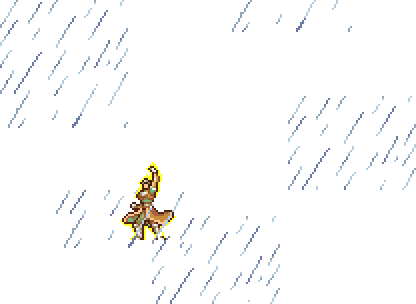
|
|
![]()
![]()
![]()
Boomerang / Cross

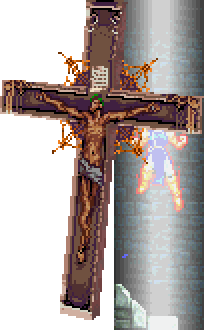
|
Nathan Graves used the Symphony version of this attack as part of the DSS card system. John Morris had a more-simplified item-crash--he'd simply arc forward three (more-traditional) boomerangs, them quickly darting straight ahead.
Finally, Julius Belmont mastered a boomerang and a cross; he used the 'rang in regular style, but his cross weapon offered him an instant crash ability--the power to create in his current position a giant flaming cross that repeatedly burns enemies. |
![]()
![]()
![]()
Axe
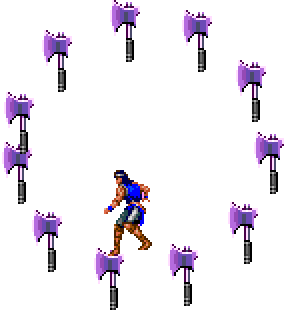
|
|
![]()
![]()
![]()
Stopwatch
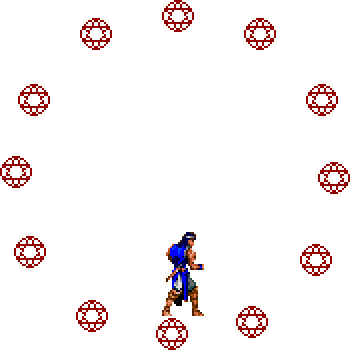
|
It's Richter Belmont, again, who does the field work, using two separate versions of a stopwatch item-crash. In the Dracula X titles, Richter becomes the center of a newly formed circle of clocks; its presence acts as a large forcefield that damages and destroys surrounding enemies as they come in contact. In Symphony of the Night, four clocks appear overhead, each one counting down from five to zero; in effect, it quadruples the time of a regular stopwatch, and, as an added bonus, sends out an electrical shock will blast all enemies onscreen after all time has elapsed.
Nathan Graves' final item crash, another of his DSS card powers, mimics the Symphony version--Nathan is granted four-times the amount of stopping power of the original model. |
![]()
![]()
![]()
No Item
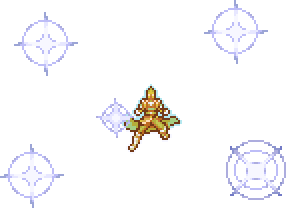 |
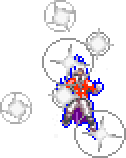 |
|
Nathan Graves built
upon this with a no-item |
![]()
![]()
![]()
Key

|
|
![]()
![]()
![]()
Blue Crystal - Spear Head
|
|
![]()
![]()
![]()
Holy Book

|
In Symphony, it gets a much larger boost: A similar book with cycling pages will initially form overhead; soon after, six particular pages, in a pentagram formation, will channel and release a wide, rainbow-colored beam at long range. This version of the crash is best utilized against minor enemies and bosses who prefer ground combat, since they'll be unable to escape its attack-width. |
![]()
![]()
![]()
Rebound Stone

|
Simon Belmont in Castlevania II: Simon's Quest was the hero who discovered the rebound stone (then known as "The Diamond") and added it to the arsenal--apparently locking it away until descendent Richter Belmont took interest in its existence. As is, these special stones will rebound about an area/room, deflecting off walls at certain angles while slicing through enemies unfortunate enough to be caught in their trajectory. We rediscover the rebound stone in Castlevania: Symphony of the Night, where it's much quicker and deadlier than its previous incarnation. As if derived from Sonia's soul powers, Richter's item-crash for this weapon is much like her Soul Bat: A powerful flash will emanate out from Richter's fist, engulfing anything within screen's length. |
![]()
![]()
![]()
Bibuti

|
Bibuti is one of Richter Belmont's "special additions" to the sub-weapon collection and one we'd never see again in following. An obvious explanation is that it's too similar to holy water, after which it's patterned: Using bibuti, Richter tosses to the ground a handful of ashes that traps and engulfs enemies that travel over them. In Symphony of the Night, where it makes its lone appearance, Richter can use the bibuti to release a continuous smoke blast upward for an extended period of time. Naturally, this is best utilized against foes that travel through the air or large bosses whose weak points are at about mid-screen. |
![]()
![]()
![]()
Aguen

|
Like bibuti, this is another of Richter's one-time additions to the arsenal. Used normally, an aguen symbol will hover through the air, damaging enemies with which it makes context. It's unique compared to other sub-weapons in that it's controllable post-release; that is, the player can continue hitting the attack button to cause the item to freeze in place and emit small lightning bolts in all directions. Richter's item-crash ability expands on this idea; the boy in blue will channel energy and release from his fist large, crippling lightning bolts, which will strike in all directions, again and again, within a limited time-period. |
![]()
![]()
![]()
Bird
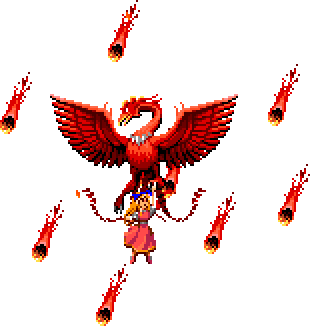
|
The Belmonts have their growing collection of sub-weapons, Maria has her cast of animal friends. But don't think there's a drop-off; her seemingly cute, cuddly companions will rain down terror on the forces of evil when enchanted via Maria's magic. Normally, Maria's bird sub-weapon will release two such feathered friends into the air at short range. The item-crash version of this "weapon" instead summons a large falcon-like creature that first swoops down, takes Maria in tow, and lifts her up to safety. Maria will now be safe from the deadly meteor storm about to hit the immediate area; all enemies onscreen will be destroyed by the debris, and bosses will surely take a pounding. |
![]()
![]()
![]()
Cat
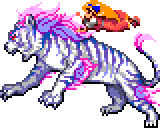
|
Maria's cat friend will ordinarily run across the ground, stopping to snip at any enemy in its path. More concerning to enemies is Maria's propensity to instead summon a tiger, which she'll mount and guide in its frightening strike: The tiger will rip across the area three times, from screen's end to screen's end on three different levels, and slice through enemies virtually everywhere onscreen. Only foes nestled in narrow safe spots between the attack lines will survive. |
![]()
![]()
![]()
Dragon
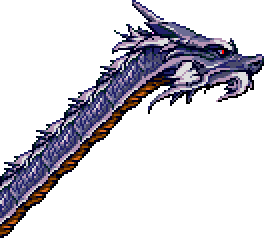
|
Without a doubt, the dragon is the most powerful and feared of Maria's cast of animal friends (if not all of the listed sub-weapons). The price of its services is already high (about five-hearts-worth of expenditure), so you can imagine the price-tag for its superpowered crash attack. For a whopping fifty hearts, that is, Maria can instead summon a huge dragon--a long-necked monstrosity that repeatedly whips its tail across the screen, almost in a blur. The fierce attack is sure to destroy any enemy currently in the frame, be it a horde of minor enemies or even a boss. |
![]()
![]()
![]()
Egg
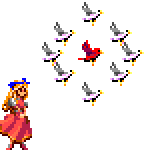
|
The egg is one of our more unconventional sub-weapons, and its quite rare to boot. Used normally, Maria will toss an egg to the ground; it'll soon crack open and release a newly born flock of birds, which will proceed to frantically flap about the area. The item-crash version of this weapon doesn't stray too far: All the same, Maria will toss an egg onto the ground; when this one cracks open, a flock containing eight white birds and one red will form a circle (with our red friend comprising its center) then dart forward in a pack, each bird scoring a single hit on the enemy. Since the crash attack is so similar to the egg's normal function (and not much more effective), it's probably not worth the effort to activate. |
![]()
![]()
![]()
Turtle
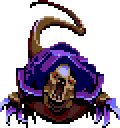
|
The turtle is another of Maria's more unique sub-weapons. It has no offensive capabilities and is instead fully defense-oriented. It'll lend to Maria its shell, which she can occupy and use as a makeshift suit of armor; the drawback is that her mobility is crippled and her jumping ability is rendered nonexistent. An item-crashed turtle, though, packs a bit of a punch: Four turtles will beam in from all corners of the screen and congregate at its center; they'll then combine into a single being--a large, vicious tortoise, which will begin wildly spinning in place, like a bladed disk, before blasting itself in whichever direction the enemy lurks. |
![]()
![]()
![]()
Music Book

|
Maria's only non-animal-friend sub-weapon is her answer to Richter's holy book. Maria will focus on one of the book's arrangements, singing a tune as it appears on a staff; her voice translates into musical notes, which are somehow damaging to the touch. When used as an item-crash, several notes will float upward, near the screen's top, and take position on an invisible staff. A tune will then begin to sound; during this period, any enemy that comes in contact with a bouncing note will suffer injury. When the last yellow note has played, the song having ended, all such notes will disappear. |
|
[Home] [What's New?] [CV Library] [Stages] [Reviews] [Weapons] [Castleography] [Multimedia] [Codes] [Links] |
||||

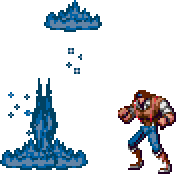
 For
centuries, holy water has been used to combat against all that represents
evil and particularly vampires. The earlier Belmonts were able to toss
holy water vials to the ground, where they would burn, smolder and engulf
enemies that travel near it. The later Belmonts would use high velocity
to cause the vial's contents to spill forward as a wave of flame. Used
as an item-crash for Richter, the watery discharge will instead take
the form of a longer, deadlier acid rains storm--each drop damaging
all enemies within a screen's distance. Extended bloodline hero Nathan
Graves adopted this item-crash, too, as part of the aforementioned DSS
card system. John Morris didn't really expand on this power,
but he was able to utilize a special crash that caused the vials' contents
to both circle high and wave forward along the ground.
For
centuries, holy water has been used to combat against all that represents
evil and particularly vampires. The earlier Belmonts were able to toss
holy water vials to the ground, where they would burn, smolder and engulf
enemies that travel near it. The later Belmonts would use high velocity
to cause the vial's contents to spill forward as a wave of flame. Used
as an item-crash for Richter, the watery discharge will instead take
the form of a longer, deadlier acid rains storm--each drop damaging
all enemies within a screen's distance. Extended bloodline hero Nathan
Graves adopted this item-crash, too, as part of the aforementioned DSS
card system. John Morris didn't really expand on this power,
but he was able to utilize a special crash that caused the vials' contents
to both circle high and wave forward along the ground.
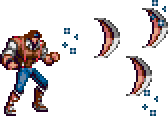 The
boomerang is nothing more than your average cross disguised as a throwing
weapon. It became the "boomerang" in North America due to
Nintendo of America's strict guidelines pertaining to religious symbols.
Under any name, it's always been a highly preferred sub-weapon, which
might be why Konami paid it so much attention in regard to crashes;
that is, Richter has had three of them:
(1) In Castlevania: Dracula X, multiple crosses will fly
about in all directions, crisscrossing rapidly. (2) In Dracula X:
Rondo of Blood, huge crucifixes blast upward from below and offscreen.
And (3) in Symphony of the Night, huge crucifixes will one after
another circle and protect Richter from all surrounding enemies; the
attack ends with a flash that spreads in either direction and serves
as a parting shot.
The
boomerang is nothing more than your average cross disguised as a throwing
weapon. It became the "boomerang" in North America due to
Nintendo of America's strict guidelines pertaining to religious symbols.
Under any name, it's always been a highly preferred sub-weapon, which
might be why Konami paid it so much attention in regard to crashes;
that is, Richter has had three of them:
(1) In Castlevania: Dracula X, multiple crosses will fly
about in all directions, crisscrossing rapidly. (2) In Dracula X:
Rondo of Blood, huge crucifixes blast upward from below and offscreen.
And (3) in Symphony of the Night, huge crucifixes will one after
another circle and protect Richter from all surrounding enemies; the
attack ends with a flash that spreads in either direction and serves
as a parting shot.
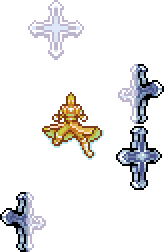
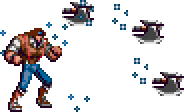
 Historically,
the axe has been the strongest of the sub-weapons, surpassing even the
Morning Star--the strongest of the standard Belmont whips. Thrown in
an arc, the axe can strike enemies both above and below with its somewhat-erratic
pattern flight path. Richter's item-crash ability causes one axe to
split into eleven, them cycling outward and flying into eleven different
directions. While each axe is only normal in strength, the crash guarantees
that all enemies will suffer at least one hit; using it against a boss,
however, will result in minimal damage compared to the pain unleashed
by the other listed crashes. Nathan Graves again borrowed a direct version
of Richter's axe crash, condensed to a more simple eight axes.
John Morris' axe crash is similar to his boomerang crash, as three axes
are arced directly in front of him before darting forward.
Historically,
the axe has been the strongest of the sub-weapons, surpassing even the
Morning Star--the strongest of the standard Belmont whips. Thrown in
an arc, the axe can strike enemies both above and below with its somewhat-erratic
pattern flight path. Richter's item-crash ability causes one axe to
split into eleven, them cycling outward and flying into eleven different
directions. While each axe is only normal in strength, the crash guarantees
that all enemies will suffer at least one hit; using it against a boss,
however, will result in minimal damage compared to the pain unleashed
by the other listed crashes. Nathan Graves again borrowed a direct version
of Richter's axe crash, condensed to a more simple eight axes.
John Morris' axe crash is similar to his boomerang crash, as three axes
are arced directly in front of him before darting forward.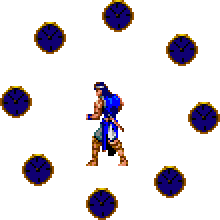 The
stopwatch has always had a strange role in the Belmonts' sub-weapon
arsenal. Its time-stopping ability was of course useful in the earlier
games, where it was effective against even bosses, but it's never been
a desired replacement for a good axe or boomerang; it became less useful
as the series went on, instead slowing down time rather than
causing its pause.
The
stopwatch has always had a strange role in the Belmonts' sub-weapon
arsenal. Its time-stopping ability was of course useful in the earlier
games, where it was effective against even bosses, but it's never been
a desired replacement for a good axe or boomerang; it became less useful
as the series went on, instead slowing down time rather than
causing its pause. 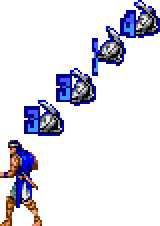 Could
the power to item-crash this weapon bring about its return to prosperity?
Could
the power to item-crash this weapon bring about its return to prosperity?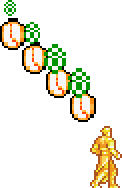
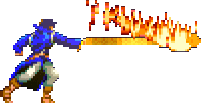
 The
Belmonts certainly aren't confined to executing crash attacks with the
usual sub-weapons--at least two of them can pull off a crash ability
with no sub-weapon in their possession. Juste Belmont started
the trend with his Spell Fusion system; by selecting the summoning book
and executing the normal attack, he could chant a healing spell. Richter
Belmont in Dracula X: Rondo of Blood preferred to harness such
a power as an offensive move, by which pushing the crash button would
result in our hero unleashing a devastating flame-whip strike; this
crash carried over to the SNES version, Castlevania: Dracula X.
Right in time for Symphony of the Night (for both PlayStation
and Saturn), he upped the scope of this crash ability, instead becoming
temporarily enchanted (enflamed, rather), able to damage enemies through
direct contact as well as with his newly enflamed whip.
The
Belmonts certainly aren't confined to executing crash attacks with the
usual sub-weapons--at least two of them can pull off a crash ability
with no sub-weapon in their possession. Juste Belmont started
the trend with his Spell Fusion system; by selecting the summoning book
and executing the normal attack, he could chant a healing spell. Richter
Belmont in Dracula X: Rondo of Blood preferred to harness such
a power as an offensive move, by which pushing the crash button would
result in our hero unleashing a devastating flame-whip strike; this
crash carried over to the SNES version, Castlevania: Dracula X.
Right in time for Symphony of the Night (for both PlayStation
and Saturn), he upped the scope of this crash ability, instead becoming
temporarily enchanted (enflamed, rather), able to damage enemies through
direct contact as well as with his newly enflamed whip.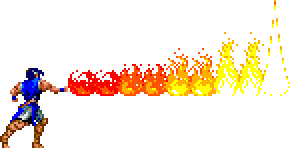 crash
that could be pulled off by combining his Pluto a
crash
that could be pulled off by combining his Pluto a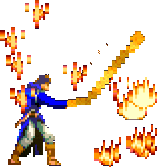 nd
Salamander DSS cards. By activating this combo with no sub-weapon equipped
(by making a 360-degree motion on the d-pad), Nathan will produce long-lasting
crash wherein he releases evil-annihilating magic flashes in all directions.
This powerful yet costly attack is the family's most destructive version
of this no-item assault.
nd
Salamander DSS cards. By activating this combo with no sub-weapon equipped
(by making a 360-degree motion on the d-pad), Nathan will produce long-lasting
crash wherein he releases evil-annihilating magic flashes in all directions.
This powerful yet costly attack is the family's most destructive version
of this no-item assault. The
idea of using a key to open locked obstructions was a core mechanic
in the MSX classic Vampire Killer, where Simon Belmont collected
and used two key types to open chests and doors, respectively. In the
PC Engine and SNES Dracula X titles, it shifts roles to sub-weapon,
where in its limited use it can be used to open locked doors in specific
stages. What many players may not realize is that the key, though a
limited-use specialty item, has some offensive power. Normally, it can
be used as a blunt, short-ranged striking weapon, its touch dealing
a bit of damage.
The
idea of using a key to open locked obstructions was a core mechanic
in the MSX classic Vampire Killer, where Simon Belmont collected
and used two key types to open chests and doors, respectively. In the
PC Engine and SNES Dracula X titles, it shifts roles to sub-weapon,
where in its limited use it can be used to open locked doors in specific
stages. What many players may not realize is that the key, though a
limited-use specialty item, has some offensive power. Normally, it can
be used as a blunt, short-ranged striking weapon, its touch dealing
a bit of damage. 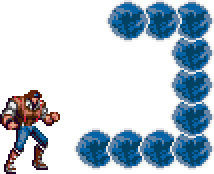 By
the time of Bloodlines, extended-family member John Morris added
a special blue crystal to the Belmont clan's arsenal. The blue crystal
is obtained by either finding a magic book or by
By
the time of Bloodlines, extended-family member John Morris added
a special blue crystal to the Belmont clan's arsenal. The blue crystal
is obtained by either finding a magic book or by 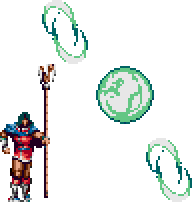 accruing
a gem-total of fifty or more. Unlike
the other listed sub-weapons, John's unique contribution has to it an
innate crash ability--any such use of the weapon resulting in the same
violent barrage. When he activates the crystal, a stream of fireballs
snakes its way to the nearest foe, engulfing and repeatedly damaging
it. Our other extended-family member, Eric Lecarde, introduces his own
new sub-weapon: A special spear head procured using the same means.
In contrast to John's homing-based crash, Eric's instead spews in all
directions a combination of large green fireballs and Guile-like sonic
blasts.
accruing
a gem-total of fifty or more. Unlike
the other listed sub-weapons, John's unique contribution has to it an
innate crash ability--any such use of the weapon resulting in the same
violent barrage. When he activates the crystal, a stream of fireballs
snakes its way to the nearest foe, engulfing and repeatedly damaging
it. Our other extended-family member, Eric Lecarde, introduces his own
new sub-weapon: A special spear head procured using the same means.
In contrast to John's homing-based crash, Eric's instead spews in all
directions a combination of large green fireballs and Guile-like sonic
blasts. The
magic book certainly isn't one of the originals, but it became a standard
sub-weapon right after Juste Belmont brought its usefulness to light
while experimenting with Spell Fusion. As
in the case of the stopwatch, Richter, our most recurring subject, has
two separate item crashes reserved for his Dracula X: Rondo
of Blood and Symphony of the Night appearances. In the Dracula
X title, the holy book floats overhead, its loose pages cycling
around it and creating a sort-of bladed pinwheel capable of damaging
surrounding enemies.
The
magic book certainly isn't one of the originals, but it became a standard
sub-weapon right after Juste Belmont brought its usefulness to light
while experimenting with Spell Fusion. As
in the case of the stopwatch, Richter, our most recurring subject, has
two separate item crashes reserved for his Dracula X: Rondo
of Blood and Symphony of the Night appearances. In the Dracula
X title, the holy book floats overhead, its loose pages cycling
around it and creating a sort-of bladed pinwheel capable of damaging
surrounding enemies.